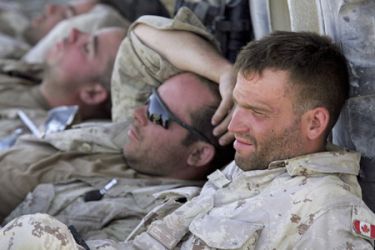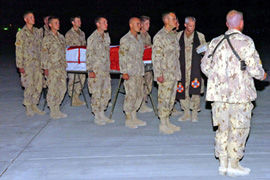Afghanistan troubles Canada
The alleged abuse of Afghans under its watch is an ominous portent for Ottawa.

 |
| Canada has worked hard to distinguish its Afghan deployment from that of the US [GALLO/GETTY] |
The 2,500 Canadian soldiers in Afghanistan were supposed to represent a friendly footprint, focussed on winning over a cynical population one village at a time.
Using a variation of the “Shape, Clear, Hold and Build” strategy that has become the rallying cry of US counter-insurgency specialists in the Obama White House, the tiny force was the very model of rectitude even amid the fog of war.
How unfortunate then that these very forces are now being accused of being benign spectators as suspected Taliban fighters were tortured by their compatriots in Afghan jails.
The allegation is not that the Canadians manhandled Afghans, but rather that Afghans treated other Afghans inhumanely.
Parliament Hill in Ottawa has been consumed by the allegations for weeks on end, drawing in the prime minister, the defence minister, several other members of cabinet, diplomats and the chief of the defence staff.
Canadians at large seem ambivalent about all the brouhaha, but to the extent that they see themselves as a moralising force in the world and champions of universal human rights, the allegations strike at the heart of their self-image.
Self-image affected
What good is Canada’s resurgence on the international stage – largely a result of its Afghan deployment – if they are going to be remembered for the sordid allegation of detainee torture, they ask.
Self-image apart, there is the important consideration of the Geneva Conventions that safeguard the rights of prisoners even after they have supposedly been transferred from Canadian to Afghan hands.
Long before Americans came around to thinking of the campaign in Afghanistan as the “just war,” Canadians had decided that they would be onside only in the struggle against al-Qaeda and the Taliban. Not for them the ill-begotten war in Iraq.
Even so, the early years since 2002 were admittedly difficult when dealing with the large number of detainees, especially given Ottawa’s reluctance to hand them over to US custody.
It was not until 2007 that Canada was able to put in place a robust detainee transfer policy, with sufficient safeguards and monitoring by the Red Cross to prevent abuse once they had been handed over to Afghan minders.
For all the bluster in Question Period and political shows on nightly television, so far, only one solid case of abuse has been unearthed.
This was seen as a “gamechanger” by the opposition because it came as an admission from Gen. Walter Natynczyk, the chief of the defence staff, barely 24 hours after a categorical assertion that the swirling accounts of maltreatment of Afghan detainees were unfounded.
The next few weeks will tell us whether this is a mountain or a molehill, as the government insists it is. But there’s no doubting the pall that this casts on otherwise signature projects that the Canadians have completed in what is seen by many as a losing battle for the affections of the Afghan people.
 |
| Prisoner abuse charges has aggravated Canada’s Afghan problems [GALLO/GETTY] |
Take, for instance, the Dand District Centre that was rebuilt by the Canadians at a cost of (Cdn) $650,000 last month.
The original three-storey structure was destroyed when two men wearing explosive vests detonated themselves last March.
Situated just south of Kandahar city, Dand is strategically important because it serves as a staging post for Taliban attackers intent on regaining their former stronghold.
The rebuilt centre is guarded by 70 Canadian soldiers round the clock, while 15 employees work within its brick walls.
That would seem like a disproportionately high cost for little dividend, but not in the eyes of the Afghans. Instead, it is a showpiece, emblematic of the grassroots work that distinguishes the Canadian footprint.
“We don’t need the rest of the world for guns and bombs, we need them for water pumps, sewage ditches, water filters, bridges – construction projects just like this one,” Nazur Gul, an elder from the Popalzai clan was quoted as saying in Dand.
“These are things the Taliban cannot do for us. Let us be responsible for keeping the insurgents away. It is the presence of American and Canadian guns that provoke them. If it is left to us, we will not let this building fall,” Gul affirms.
This Canadian approach of keeping the insurgents at bay is what has finally won favour in Washington as well.
In the words of Anthony H. Cordesman of the Center for Strategic and International Studies in Washington, the “Shape, Clear, Hold and Build” strategy is premised on just such feel-good projects.
“Exploit the security space to deliver humanitarian relief and implement reconstruction and development initiatives that will connect the Afghan population to its government, and build and sustain the Afghanistan envisioned in the strategic goals.”
What that strategic goal is for Canada or for its NATO partners is hard to define, but clearly, the abuse of Afghans under the watch of foreign forces is an ominous portent.
As the countdown to a Canadian pullout in 2011 begins, incubating a central government in Kabul that will guarantee the human rights of its own people would seem like an extraordinarily taller order.